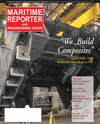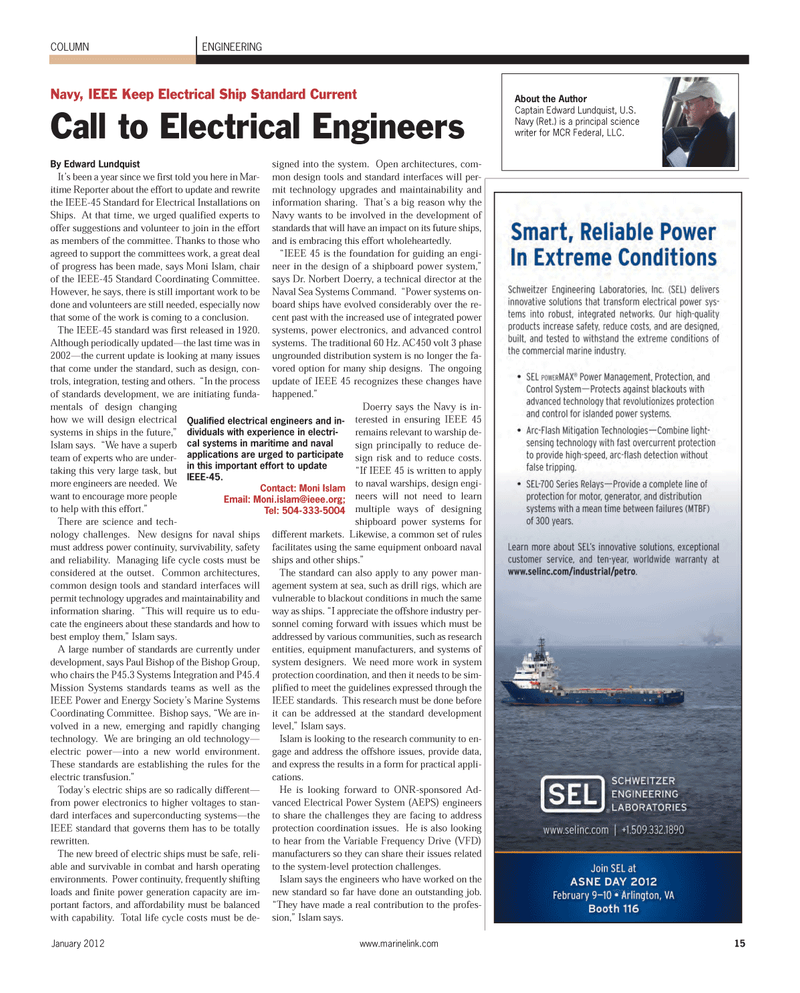
Page 15: of Maritime Reporter Magazine (January 2012)
US Navy Report
Read this page in Pdf, Flash or Html5 edition of January 2012 Maritime Reporter Magazine
By Edward Lundquist It?s been a year since we first told you here in Mar- itime Reporter about the effort to update and rewrite the IEEE-45 Standard for Electrical Installations onShips. At that time, we urged qualified experts to offer suggestions and volunteer to join in the effort as members of the committee. Thanks to those who agreed to support the committees work, a great deal of progress has been made, says Moni Islam, chairof the IEEE-45 Standard Coordinating Committee.However, he says, there is still important work to be done and volunteers are still needed, especially now that some of the work is coming to a conclusion. The IEEE-45 standard was first released in 1920. Although periodically updated?the last time was in 2002?the current update is looking at many issues that come under the standard, such as design, con-trols, integration, testing and others. ?In the process of standards development, we are initiating funda- mentals of design changinghow we will design electrical systems in ships in the future,? Islam says. ?We have a superb team of experts who are under- taking this very large task, but more engineers are needed. We want to encourage more people to help with this effort.? There are science and tech-nology challenges. New designs for naval ships must address power continuity, survivability, safety and reliability. Managing life cycle costs must be considered at the outset. Common architectures,common design tools and standard interfaces will permit technology upgrades and maintainability andinformation sharing. ?This will require us to edu-cate the engineers about these standards and how to best employ them,? Islam says. A large number of standards are currently under development, says Paul Bishop of the Bishop Group, who chairs the P45.3 Systems Integration and P45.4 Mission Systems standards teams as well as theIEEE Power and Energy Society?s Marine Systems Coordinating Committee. Bishop says, ?We are in- volved in a new, emerging and rapidly changing technology. We are bringing an old technology? electric power?into a new world environment. These standards are establishing the rules for theelectric transfusion.? Today?s electric ships are so radically different? from power electronics to higher voltages to stan- dard interfaces and superconducting systems?the IEEE standard that governs them has to be totally rewritten. The new breed of electric ships must be safe, reli- able and survivable in combat and harsh operating environments. Power continuity, frequently shifting loads and finite power generation capacity are im- portant factors, and affordability must be balanced with capability. Total life cycle costs must be de- signed into the system. Open architectures, com-mon design tools and standard interfaces will per- mit technology upgrades and maintainability andinformation sharing. That?s a big reason why the Navy wants to be involved in the development of standards that will have an impact on its future ships, and is embracing this effort wholeheartedly. ?IEEE 45 is the foundation for guiding an engi-neer in the design of a shipboard power system,? says Dr. Norbert Doerry, a technical director at the Naval Sea Systems Command. ?Power systems on- board ships have evolved considerably over the re- cent past with the increased use of integrated power systems, power electronics, and advanced control systems. The traditional 60 Hz. AC450 volt 3 phase ungrounded distribution system is no longer the fa- vored option for many ship designs. The ongoing update of IEEE 45 recognizes these changes have happened.? Doerry says the Navy is in- terested in ensuring IEEE 45remains relevant to warship de- sign principally to reduce de-sign risk and to reduce costs.?If IEEE 45 is written to applyto naval warships, design engi- neers will not need to learnmultiple ways of designing shipboard power systems for different markets. Likewise, a common set of rules facilitates using the same equipment onboard naval ships and other ships.? The standard can also apply to any power man- agement system at sea, such as drill rigs, which arevulnerable to blackout conditions in much the same way as ships. ?I appreciate the offshore industry per- sonnel coming forward with issues which must be addressed by various communities, such as research entities, equipment manufacturers, and systems of system designers. We need more work in system protection coordination, and then it needs to be sim-plified to meet the guidelines expressed through the IEEE standards. This research must be done before it can be addressed at the standard development level,? Islam says. Islam is looking to the research community to en-gage and address the offshore issues, provide data, and express the results in a form for practical appli- cations. He is looking forward to ONR-sponsored Ad- vanced Electrical Power System (AEPS) engineers to share the challenges they are facing to address protection coordination issues. He is also lookingto hear from the Variable Frequency Drive (VFD) manufacturers so they can share their issues related to the system-level protection challenges. Islam says the engineers who have worked on the new standard so far have done an outstanding job. ?They have made a real contribution to the profes- sion,? Islam says. ENGINEERINGCOLUMNAbout the AuthorCaptain Edward Lundquist, U.S. Navy (Ret.) is a principal sciencewriter for MCR Federal, LLC.Navy, IEEE Keep Electrical Ship Standard Current Call to Electrical EngineersQualified electrical engineers and in-dividuals with experience in electri-cal systems in maritime and navalapplications are urged to participate in this important effort to update IEEE-45. Contact: Moni IslamEmail: [email protected]; Tel: 504-333-5004 January 2012www.marinelink.com 15MR Jan.12 # 2 (10-17):MR Template 1/11/2012 3:49 PM Page 15

 14
14

 16
16
